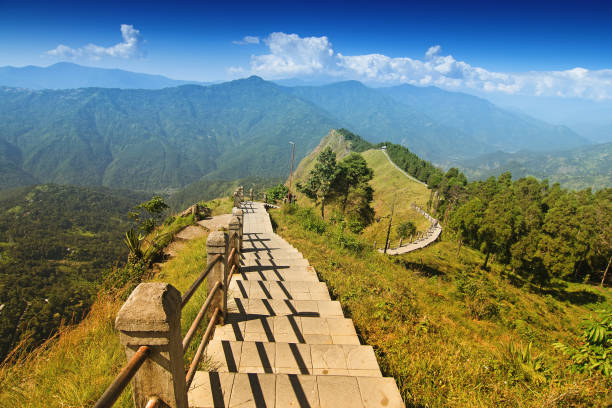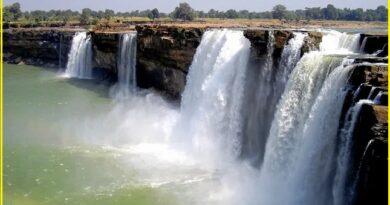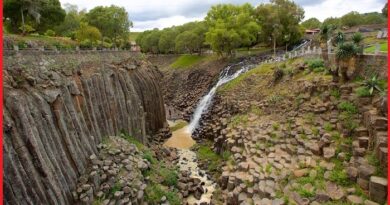Namchi Escapades: A Journey through Sikkim’s Serenity
Namchi Sikkim
Namchi is a picturesque town located in the South Sikkim district of the Indian state of Sikkim. Namchi is also an important cultural and pilgrimage destination known for its scenic beauty. Namchi is known for Samdruptse Hill, famous for the towering statue of Guru Padmasambhava, also known as Guru Rinpoche, which stands at 118 feet. It is one of the tallest statues of Guru Padmasambhava in the world. Char Dham is Also known as Siddhesvara Dham, this complex replicates the four sacred Dhams of India (Badrinath, Jagannath, Dwarka, and Rameswaram) along with a giant statue of Lord Shiva. It is a major pilgrimage site and attracts numerous visitors.
Namchi, like much of Sikkim, is rich in biodiversity. The region is home to a variety of flora and fauna, making it a haven for nature lovers and bird watchers. Namchi celebrates various local festivals with great enthusiasm, reflecting the rich cultural heritage of Sikkim. Some notable festivals include the Namchi Mahotsav and Maghey Sankranti Mela.
1. Namchi Chardham
Namchi Char Dham, also known as Siddhesvara Dham, is a significant pilgrimage site located in Namchi, South Sikkim. This complex is a major attraction, drawing visitors for its spiritual significance and architectural grandeur. The Char Dham complex was inaugurated in 2011 by the then Chief Minister of Sikkim, Pawan Chamling. Situated on Solophok Hill, about 5 kilometers from the main town of Namchi.
The centerpiece of Char Dham is a towering 108-foot statue of Lord Shiva seated in a meditative pose, symbolizing peace and spirituality. This statue can be seen from various points around Namchi.
Replicas of Char Dhams-
Badrinath: A replica of the Badrinath Temple in Uttarakhand, dedicated to Lord Vishnu.
Jagannath: A replica of the Jagannath Temple in Puri, Odisha, dedicated to Lord Jagannath (a form of Krishna).
Dwarka: A replica of the Dwarkadhish Temple in Gujarat, dedicated to Lord Krishna.
Rameswaram: A replica of the Ramanathaswamy Temple in Tamil Nadu, dedicated to Lord Shiva.
2. Namchi weather
Namchi, located in the South Sikkim district, experiences a temperate climate throughout the year. Here’s a detailed overview of the weather patterns you can expect in Namchi-
Spring (March to May)
Temperature: Ranges from 10°C to 25°C . Weather: Mild and pleasant with blooming flowers and lush greenery. It’s an ideal time for sightseeing and outdoor activities.
Summer (June to August)
Temperature: Ranges from 15°C to 28°C. Weather: Warm but comfortable. However, this is also the monsoon season, so expect heavy rainfall, especially in July and August. The rains bring out the lushness of the landscape but can also cause travel disruptions due to landslides.
Autumn (September to November)
Temperature: Ranges from 10°C to 25°C. Weather: Clear skies and mild weather make this another ideal time to visit. The post-monsoon period brings fresh, clean air and vibrant landscapes.
Winter (December to February)
Temperature: Ranges from 5°C to 15°C. Weather: Cold but generally dry. The nights can be quite chilly, and frost is common in the early mornings. It’s a good time to visit if you enjoy colder weather and want to avoid the monsoon season.
Best Time to Visit
Spring (March to May) and Autumn (September to November) are the best times to visit Namchi. During these periods, the weather is pleasant, and you can enjoy the natural beauty and outdoor activities without the disruption of heavy rains or extreme cold.
Also read- Azure Majesty: Discovering Tsomgo Lake in Sikkim
3. Namchi sightseeing
Namchi, the capital of South Sikkim, is a beautiful town that offers a variety of attractions for sightseeing.
Samdruptse Hill
Attraction: The hill features a towering 118-foot statue of Guru Padmasambhava (Guru Rinpoche), the patron saint of Sikkim. The statue is gilded in copper and gold, making it a striking landmark. Experience: The site offers panoramic views of the surrounding hills and valleys. It is a peaceful spot for meditation and reflection.

Char Dham (Siddhesvara Dham)
Attraction: This pilgrimage site houses replicas of the four Dhams (Badrinath, Jagannath, Dwarka, and Rameswaram) and a large statue of Lord Shiva. Experience: The complex provides a spiritual ambiance with its beautifully landscaped gardens and serene environment. It’s a major draw for pilgrims and tourists alike.
Temi Tea Garden
Attraction: The only tea estate in Sikkim, renowned for producing high-quality organic tea. Experience: Visitors can walk through the lush tea gardens, learn about tea processing, and enjoy the scenic vistas. There’s also a tea-tasting session available for tea enthusiasts.
Namchi Rock Garden
Attraction: Located on the way to Samdruptse, this garden features a variety of plants, trees, and flowers, along with beautifully crafted pathways and water bodies. Experience: It’s a great spot for a stroll, photography, and enjoying the natural beauty of the area.
Tendong Hill
Attraction: A popular trekking destination, it offers stunning views of the Himalayan range, including Mount Kanchenjunga. Experience: The trek to Tendong Hill is rewarding, with lush forests and the opportunity to spot local wildlife and birds.
4. Gangtok to Namchi Distance
The distance between Gangtok, the capital city of Sikkim, and Namchi, the headquarters of South Sikkim, is approximately 75 kilometers by road. If you traveling by Car the most common route is via NH10 and Namchi-Ravangla Road. The drive offers scenic views of the mountains and valleys of Sikkim. Regular bus services are available from Gangtok to Namchi. It’s a budget-friendly option but less comfortable compared to a private taxi.
5. Siliguri to Namchi distance
The distance between Siliguri, a major town in West Bengal, and Namchi, the capital of South Sikkim, is approximately 90 kilometers by road. If you are travelling by car the most common route is via NH10 through Teesta Bazaar and Melli. From Melli, you’ll take the Namchi-Ravangla Road to reach Namchi. Regular bus services are available from Siliguri to Namchi.
The roads from Siliguri to Namchi are generally well-maintained, with some stretches passing through hilly terrain. However, it’s advisable to be cautious of sharp turns and steep climbs, especially during the monsoon season when landslides can occur.



